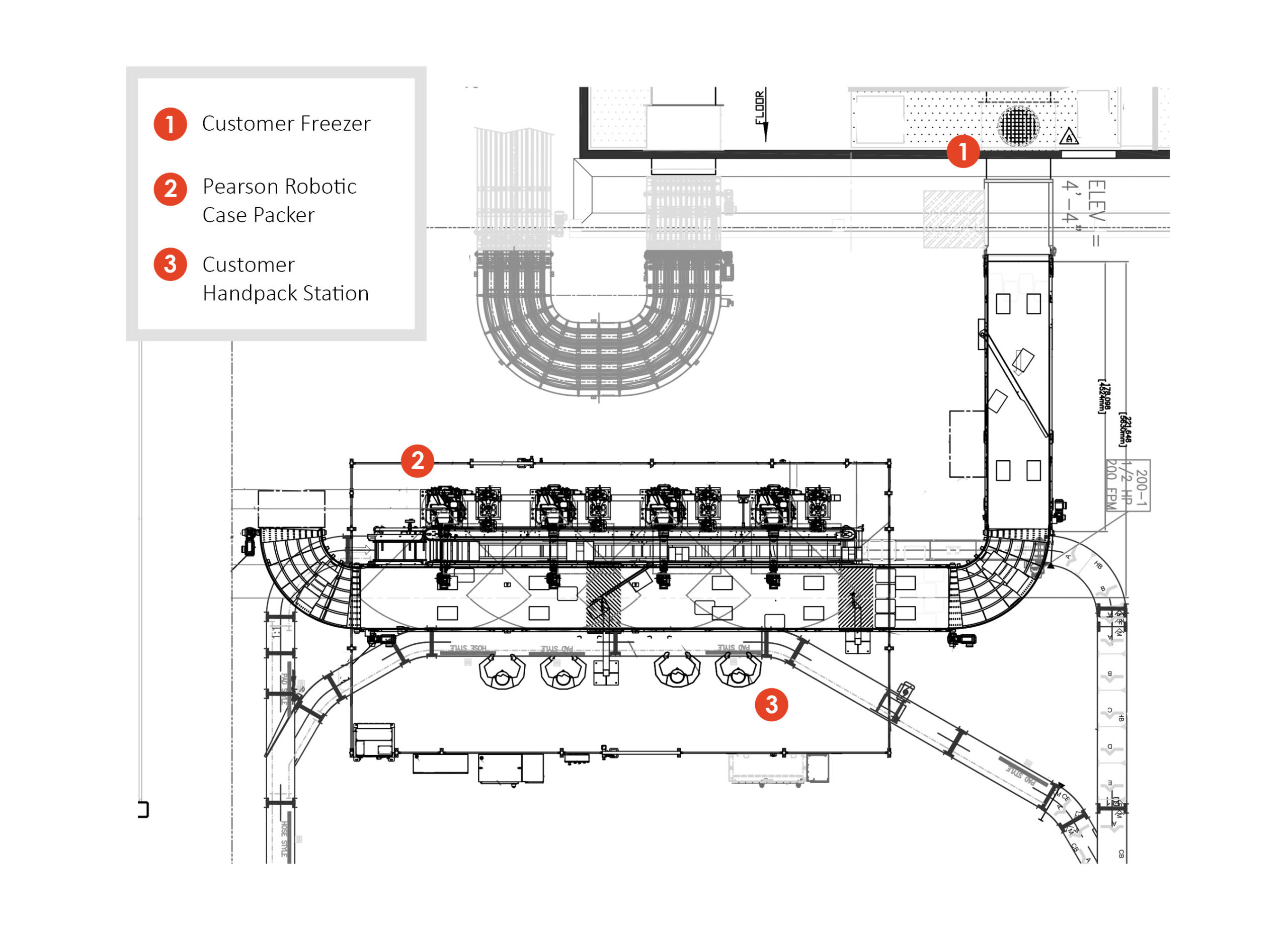This frozen roll manufacturer had recently signed a contract with a leading US fast-food chain. To reach the agreed-upon production volumes, they would need to install a dedicated packing line at their Kentucky facility. Currently using a Pearson Bag Inserter in another area of their operation, the customer had an established relationship and confidence in Pearson’s ability to provide a solution that would fit the bill.
Project Overview
Objective 1: Product and pack integrity
The rolls are packed frozen in plastic-wrapped foil trays. The solution would need to handle the trays from the freezer discharge where they exit in random/skewed orientation four trays wide, into the packing cell.
Additionally, the customer warned that tray lips must be protected from being bent, crushed, or overlapping other trays in the case.
Pearson Solutions
To manage the frozen product, a 40” wide plastic chain conveyor designed to prevent ice buildup carries product from the freezer exit through the cell. In preparation for an accurate pick, FANUC 2D Vision tracks product location and orientation.
The end-of-arm tools are equipped with one or two high-flow vacuum plenums, depending on the selected pack pattern. As the robot arm rotates for a proper pick, the plenum(s) deploy downward one at a time. For dual-stack patterns, the ability to pick, reposition, then pick again, ensures trays are in alignment. Once the second tray is picked, an actuator pushes the trays closer together to ensure no overlapping or flap interference occurs during placement into the case.
Objective 2: Greater reliability & efficiency
It was important to the customer to build in safety measures that anticipate and mitigate unforeseen downtime of individual robots or the entire system.
Pearson Solutions
To provide the desired redundancy, the system has built-in surge capacity. Under normal conditions, four FANUC M710iC/50 robots share the workload, but if conditions change, three robots have the ability to meet the same output requirements. This also enables the customer to handle temporary production volume increases.
Additionally, an existing handpack station located next to the robotic packer can be utilized if necessary. The robots go into safe mode and an automatic plowing device routes products to the side of the shared conveyor nearest the manual station.
Objective 3: Minimal disruptions to production
Running pack patterns with both single and double stacks of trays, frequent changeovers needed to be as short as possible and require as few resources as possible.
Pearson Solutions
Each of the robots has two end-of-arm tools: one for single-stack recipes and another for dual-stack recipes. Automatic tool change functionality replaces all four tools simultaneously with the simple click of an HMI button.
Sequence of Operations
A modular plastic chain conveyor designed to prevent ice build-up transports products in random orientation from the customer’s freezer to the packer. The position of each product is determined at the packer infeed using a 2D vision camera and conveyor line tracking, and then communicated to each of the robots in the cell. Products are picked one at a time from the product conveyor using a single or double high blow vacuum plenum(s), depending on the pack pattern. With a dual stack pattern, the plenums deploy and retract alternately to ensure that the picked trays are aligned and to avoid interference with other products on the conveyor. Before final placement into the case, the two plenums shift together via an actuator to ensure a snug fit of the product in the case and to avoid any snag points.
Simultaneously, empty cases travel toward the cell narrow side leading. A case escapement releases cases one at a time onto the sidebelt case transfer conveyors. After passing through the case packer, full cases are released from the side belt conveyors and transferred to the downstream conveying system.
In the event the robots fault or are otherwise unable to pack cases, opening the fence will disable the robots into safe mode, while the product conveyor continues running. An automatic plowing device diverts product to the side of the belt nearest the handpack station so manual operations can continue.



